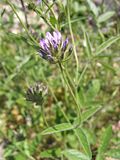| Bituminaria bituminosa | |
|---|---|
 | |
| Scientific classification | |
| Kingdom: | Plantae |
| Clade: | Tracheophytes |
| Clade: | Angiosperms |
| Clade: | Eudicots |
| Clade: | Rosids |
| Order: | Fabales |
| Family: | Fabaceae |
| Subfamily: | Faboideae |
| Genus: | Bituminaria |
| Species: | B. bituminosa |
| Binomial name | |
| Bituminaria bituminosa (L.) C.H.Stirt. | |
| Subspecies | |
Bituminaria bituminosa var. albomarginata (Canary Islands): Albo Tedera Contents | |
| Synonyms | |
Psoralea bituminosa L. | |
Bituminaria bituminosa, the Arabian pea or pitch trefoil, [1] is a perennial Mediterranean herb species in the genus Bituminaria .
The pterocarpans bitucarpin A and B can be isolated from the aerial parts of B. bituminosa. [2]
It has several potential uses: (i) forage crop, (ii) Phytostabilization of heavy metal contaminated or degraded soils, (iii) Synthesis of furanocoumarins (psoralen, angelicin, xanthotoxin and bergapten), compounds of broad pharmaceutical interest.
It is easily recognizable by the characteristic smell of bitumen from its leaves. This strong tar-like characteristic aroma appears to be the result of a combination of several substances such as phenolics, sulphurated compounds, sesquiterpenes and probably short-chain hydrocarbon. Total polyphenols content was < 2% and the condensed tannins was <0.8% in a dry weight basis.











